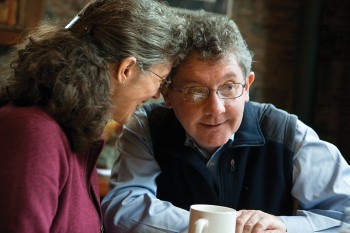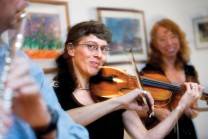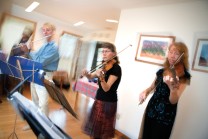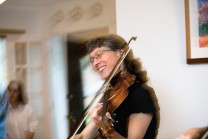COVER STORY SIDEBAR
When a faculty hire depends on two jobs, not just one

Kathy Selby and Samus Davis during a quiet moment together at a local café. See larger image
Sometimes the key to enlisting a new faculty member is the offer of a position to a partner. The decision by Séamus Davis to accept a faculty position at Cornell was greatly influenced by a teaching opportunity for his physicist wife, Kathy Selby.
Early in her career Selby decided to have "balance" in her life, combining academics and music. "It runs in my father's family. We like to do a bunch of things," she explains. "A lot of women talk about the glass ceiling. I decided to turn it around and make the life I wanted."

Kathy Selby plays the fiddle (with a few fellow musicians) during an English country dance party at her home this fall. See larger image
Her mother was a musician, and Selby studied classical violin as a child. Visiting Ireland with Davis she met his uncle – the Séamus for whom he was named – a renowned musician and storyteller. She brought home a book of Irish tunes and started playing them alongside the Vivaldi, and soon found more Celtic music at a San Francisco street fair. To make more time for music, she switched from an adjunct professorship at the University of California-San Francisco to a half-time research position.
Coming into Ithaca's vibrant folk music community, she opted for a similar arrangement, devoting what she calls "50 percent time" to physics, and the rest to teaching fiddle and playing in local bands that play for contra dances (a New England descendant of English country dancing done to traditional fiddle tunes, very popular in academic communities).

Kathy Selby plays the fiddle (with a few fellow musicians) during an English country dance party at her home this fall. See larger image
Cornell's physics department was already offering a course called The Physics of Musical Sound, and they handed it to Selby – a perfect fit. In alternate semesters she teaches physics for bioscience majors.
"Nowadays it often seems that both people in a couple are looking for a job, so you have to recruit families, not just individuals," says Betsy Hillman, dual career consultant in the Division of Human Resources. The Dual Career Program was created in 2001 by then-Provost Biddy Martin.
Female physicists tend to marry physicists, says newly arrived assistant professor Eun-Ah Kim, because the ratio of men to women among physics grad students is about 25 to one. (Selby had the same experience.) Kim's husband, Michael Lawler, found a job as professor of physics at Binghamton University and has an adjunct professorship at Cornell that allows him to collaborate with Kim and other researchers.

Kathy Selby plays the fiddle (with a few fellow musicians) during an English country dance party at her home this fall. See larger image
When the partner is an academic, employment arrangements are often made through contacts within or between departments, sometimes coordinated through the provost's office. Candidates also can make use of the Upstate New York Higher Education Recruitment Consortium (UNY HERC), which maintains a database of faculty and staff jobs at member institutions in central New York. For nonacademics Hillman maintains contacts throughout the community. "I urge departments to include information about UNY HERC and the Dual Career Program in their recruitment materials," Hillman says.
The Division of Human Resources also helps make Cornell attractive for arriving faculty families with an on-campus child care center, a program to help defray child care expenses, a lactation time-away-from-work policy and an adoption assistance program. Kim, who gave birth to a baby boy in September, benefits from a Cornell policy that stops the tenure clock for one year for new parents and exempted her from teaching for the fall semester.